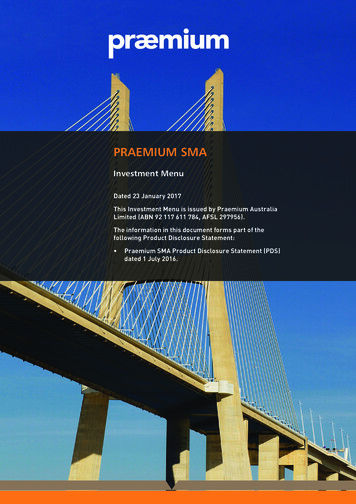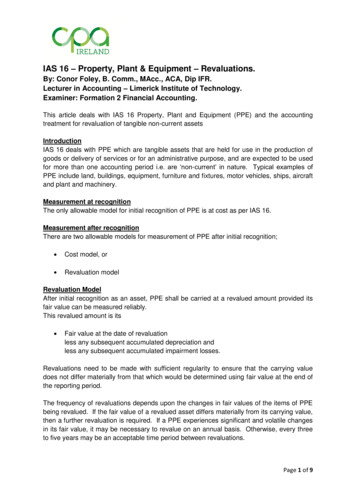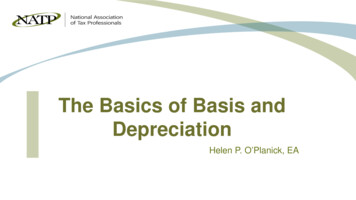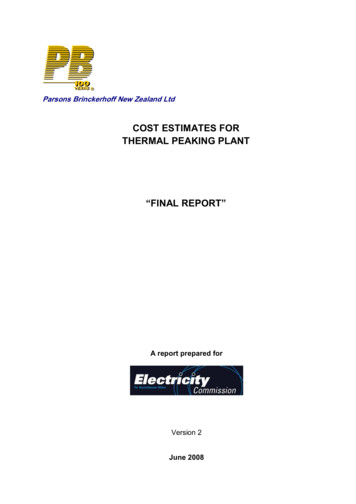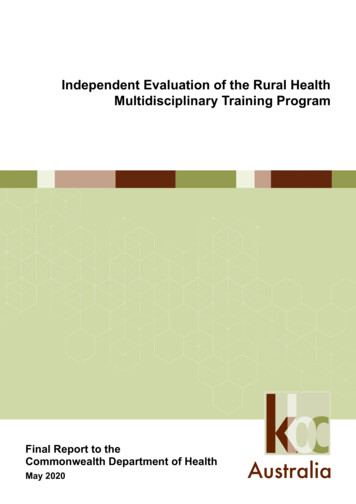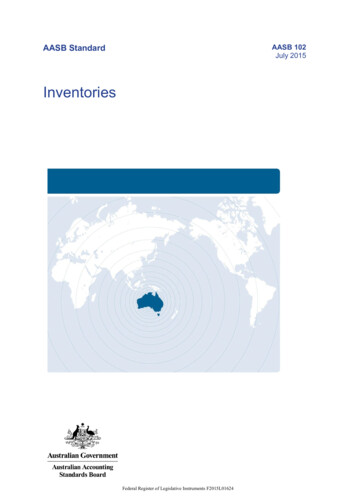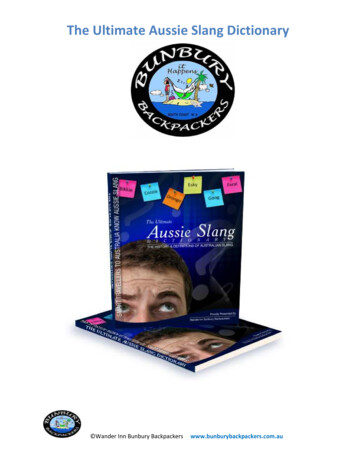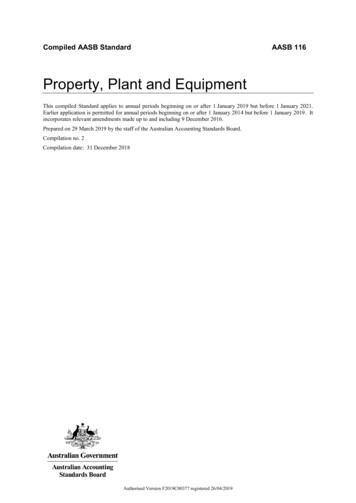
Transcription
Compiled AASB StandardAASB 116Property, Plant and EquipmentThis compiled Standard applies to annual periods beginning on or after 1 January 2019 but before 1 January 2021.Earlier application is permitted for annual periods beginning on or after 1 January 2014 but before 1 January 2019. Itincorporates relevant amendments made up to and including 9 December 2016.Prepared on 29 March 2019 by the staff of the Australian Accounting Standards Board.Compilation no. 2Compilation date: 31 December 2018Authorised Version F2019C00377 registered 26/04/2019
Obtaining copies of Accounting StandardsCompiled versions of Standards, original Standards and amending Standards (see Compilation Details) are availableon the AASB website: www.aasb.gov.au.Australian Accounting Standards BoardPO Box 204Collins Street WestVictoria 8007AUSTRALIAPhone:E-mail:Website:(03) 9617 7637standard@aasb.gov.auwww.aasb.gov.auOther enquiriesPhone:E-mail:(03) 9617 7600standard@aasb.gov.auCOPYRIGHT Commonwealth of Australia 2019This compiled AASB Standard contains IFRS Foundation copyright material. Reproduction within Australia inunaltered form (retaining this notice) is permitted for personal and non-commercial use subject to the inclusion of anacknowledgment of the source. Requests and enquiries concerning reproduction and rights for commercial purposeswithin Australia should be addressed to The National Director, Australian Accounting Standards Board, PO Box 204,Collins Street West, Victoria 8007.All existing rights in this material are reserved outside Australia. Reproduction outside Australia in unaltered form(retaining this notice) is permitted for personal and non-commercial use only. Further information and requests forauthorisation to reproduce for commercial purposes outside Australia should be addressed to the IFRS Foundation atwww.ifrs.org.AASB 116-compiled2Authorised Version F2019C00377 registered 26/04/2019COPYRIGHT
ContentsCOMPARISON WITH IAS 16ACCOUNTING STANDARDAASB 116 PROPERTY, PLANT AND al costsSubsequent costsMEASUREMENT AT RECOGNITIONElements of costMeasurement of costMEASUREMENT AFTER RECOGNITIONCost modelRevaluation modelDepreciationDepreciable amount and depreciation periodDepreciation methodImpairmentCompensation for impairmentDERECOGNITIONDISCLOSURETRANSITIONAL PROVISIONSEFFECTIVE DATEWITHDRAWAL OF OTHER PRONOUNCEMENTSCOMMENCEMENT OF THE LEGISLATIVE INSTRUMENTWITHDRAWAL OF AASB PRONOUNCEMENTSAPPENDICESA Australian defined termsB Australian reduced disclosure requirementsAUSTRALIAN IMPLEMENTATION GUIDANCECOMPILATION DETAILSDELETED IAS 16 TEXTfrom us83.1Aus83.2AVAILABLE ON THE AASB WEBSITEBasis for Conclusions on IAS 16Australian Accounting Standard AASB 116 Property, Plant and Equipment (as amended) is set out in paragraphs 1 –Aus83.2 and Appendices A – B. All the paragraphs have equal authority. Paragraphs in bold type state the mainprinciples. AASB 116 is to be read in the context of other Australian Accounting Standards, including AASB 1048Interpretation of Standards, which identifies the Australian Accounting Interpretations, and AASB 1057 Applicationof Australian Accounting Standards. In the absence of explicit guidance, AASB 108 Accounting Policies, Changes inAccounting Estimates and Errors provides a basis for selecting and applying accounting policies.AASB 116-compiled3Authorised Version F2019C00377 registered 26/04/2019CONTENTS
Comparison with IAS 16AASB 116 Property, Plant and Equipment as amended incorporates IAS 16 Presentation of Financial Statements asissued and amended by the International Accounting Standards Board (IASB). Australian-specific paragraphs (whichare not included in IAS 16) are identified with the prefix “Aus” or “RDR”. Paragraphs that apply only to not-forprofit entities begin by identifying their limited applicability.Tier 1For-profit entities complying with AASB 116 also comply with IAS 16.Not-for-profit entities’ compliance with IAS 16 will depend on whether any “Aus” paragraphs that specifically applyto not-for-profit entities provide additional guidance or contain applicable requirements that are inconsistent withIAS 16.Tier 2Entities preparing general purpose financial statements under Australian Accounting Standards – Reduced DisclosureRequirements (Tier 2) will not be in compliance with IFRS Standards.AASB 1053 Application of Tiers of Australian Accounting Standards explains the two tiers of reporting requirements.AASB 116-compiled4Authorised Version F2019C00377 registered 26/04/2019COMPARISON
Accounting Standard AASB 116The Australian Accounting Standards Board made Accounting Standard AASB 116 Property, Plant and Equipmentunder section 334 of the Corporations Act 2001 on 7 August 2015.This compiled version of AASB 116 applies to annual periods beginning on or after 1 January 2019 but before1 January 2021. It incorporates relevant amendments contained in other AASB Standards made by the AASB up toand including 9 December 2016 (see Compilation Details).Accounting Standard AASB 116Property, Plant and EquipmentObjective1The objective of this Standard is to prescribe the accounting treatment for property, plant and equipment sothat users of the financial statements can discern information about an entity’s investment in its property,plant and equipment and the changes in such investment. The principal issues in accounting for property,plant and equipment are the recognition of the assets, the determination of their carrying amounts and thedepreciation charges and impairment losses to be recognised in relation to them.Scope2This Standard shall be applied in accounting for property, plant and equipment except when anotherStandard requires or permits a different accounting treatment.3This Standard does not apply to:(a)property, plant and equipment classified as held for sale in accordance with AASB 5 Non-currentAssets Held for Sale and Discontinued Operations.(b)biological assets related to agricultural activity other than bearer plants (see AASB 141Agriculture). This Standard applies to bearer plants but it does not apply to the produce on bearerplants.(c)the recognition and measurement of exploration and evaluation assets (see AASB 6 Explorationfor and Evaluation of Mineral Resources).(d)mineral rights and mineral reserves such as oil, natural gas and similar non-regenerativeresources.However, this Standard applies to property, plant and equipment used to develop or maintain the assetsdescribed in (b)–(d).4[Deleted]5An entity using the cost model for investment property in accordance with AASB 140 Investment Propertyshall use the cost model in this Standard for owned investment property.Definitions6The following terms are used in this Standard with the meanings specified:A bearer plant is a living plant that:(a)is used in the production or supply of agricultural produce;(b)is expected to bear produce for more than one period; and(c)has a remote likelihood of being sold as agricultural produce, except for incidental scrapsales.(Paragraphs 5A–5B of AASB 141 elaborate on this definition of a bearer plant.)AASB 116-compiled5Authorised Version F2019C00377 registered 26/04/2019STANDARD
Carrying amount is the amount at which an asset is recognised after deducting any accumulateddepreciation and accumulated impairment losses.Cost is the amount of cash or cash equivalents paid or the fair value of the other consideration givento acquire an asset at the time of its acquisition or construction or, where applicable, the amountattributed to that asset when initially recognised in accordance with the specific requirements ofother Australian Accounting Standards, eg AASB 2 Share-based Payment.Depreciable amount is the cost of an asset, or other amount substituted for cost, less its residual value.Depreciation is the systematic allocation of the depreciable amount of an asset over its useful life.Entity-specific value is the present value of the cash flows an entity expects to arise from thecontinuing use of an asset and from its disposal at the end of its useful life or expects to incur whensettling a liability.Fair value is the price that would be received to sell an asset or paid to transfer a liability in anorderly transaction between market participants at the measurement date. (See AASB 13 Fair ValueMeasurement.)An impairment loss is the amount by which the carrying amount of an asset exceeds its recoverableamount.Property, plant and equipment are tangible items that:(a)are held for use in the production or supply of goods or services, for rental to others, or foradministrative purposes; and(b)are expected to be used during more than one period.Recoverable amount is the higher of an asset’s fair value less costs to sell and its value in use.The residual value of an asset is the estimated amount that an entity would currently obtain fromdisposal of the asset, after deducting the estimated costs of disposal, if the asset were already of theage and in the condition expected at the end of its useful life.Useful life is:(a)the period over which an asset is expected to be available for use by an entity; or(b)the number of production or similar units expected to be obtained from the asset by anentity.Recognition7The cost of an item of property, plant and equipment shall be recognised as an asset if, and only if:(a)it is probable that future economic benefits associated with the item will flow to the entity;and(b)the cost of the item can be measured reliably.8Items such as spare parts, stand-by equipment and servicing equipment are recognised in accordance withthis Standard when they meet the definition of property, plant and equipment. Otherwise, such items areclassified as inventory.9This Standard does not prescribe the unit of measure for recognition, ie what constitutes an item ofproperty, plant and equipment. Thus, judgement is required in applying the recognition criteria to an entity’sspecific circumstances. It may be appropriate to aggregate individually insignificant items, such as moulds,tools and dies, and to apply the criteria to the aggregate value.10An entity evaluates under this recognition principle all its property, plant and equipment costs at the timethey are incurred. These costs include costs incurred initially to acquire or construct an item of property,plant and equipment and costs incurred subsequently to add to, replace part of, or service it. The cost of anitem of property, plant and equipment may include costs incurred relating to leases of assets that are used toconstruct, add to, replace part of or service an item of property, plant and equipment, such as depreciation ofright-of-use assets.Initial costs11Items of property, plant and equipment may be acquired for safety or environmental reasons. Theacquisition of such property, plant and equipment, although not directly increasing the future economicAASB 116-compiled6Authorised Version F2019C00377 registered 26/04/2019STANDARD
benefits of any particular existing item of property, plant and equipment, may be necessary for an entity toobtain the future economic benefits from its other assets. Such items of property, plant and equipmentqualify for recognition as assets because they enable an entity to derive future economic benefits fromrelated assets in excess of what could be derived had those items not been acquired. For example, achemical manufacturer may install new chemical handling processes to comply with environmentalrequirements for the production and storage of dangerous chemicals; related plant enhancements arerecognised as an asset because without them the entity is unable to manufacture and sell chemicals.However, the resulting carrying amount of such an asset and related assets is reviewed for impairment inaccordance with AASB 136 Impairment of Assets.Subsequent costs12Under the recognition principle in paragraph 7, an entity does not recognise in the carrying amount of anitem of property, plant and equipment the costs of the day-to-day servicing of the item. Rather, these costsare recognised in profit or loss as incurred. Costs of day-to-day servicing are primarily the costs of labourand consumables, and may include the cost of small parts. The purpose of these expenditures is oftendescribed as for the ‘repairs and maintenance’ of the item of property, plant and equipment.13Parts of some items of property, plant and equipment may require replacement at regular intervals. Forexample, a furnace may require relining after a specified number of hours of use, or aircraft interiors such asseats and galleys may require replacement several times during the life of the airframe. Items of property,plant and equipment may also be acquired to make a less frequently recurring replacement, such asreplacing the interior walls of a building, or to make a nonrecurring replacement. Under the recognitionprinciple in paragraph 7, an entity recognises in the carrying amount of an item of property, plant andequipment the cost of replacing part of such an item when that cost is incurred if the recognition criteria aremet. The carrying amount of those parts that are replaced is derecognised in accordance with thederecognition provisions of this Standard (see paragraphs 67–72).14A condition of continuing to operate an item of property, plant and equipment (for example, an aircraft)may be performing regular major inspections for faults regardless of whether parts of the item are replaced.When each major inspection is performed, its cost is recognised in the carrying amount of the item ofproperty, plant and equipment as a replacement if the recognition criteria are satisfied. Any remainingcarrying amount of the cost of the previous inspection (as distinct from physical parts) is derecognised. Thisoccurs regardless of whether the cost of the previous inspection was identified in the transaction in whichthe item was acquired or constructed. If necessary, the estimated cost of a future similar inspection may beused as an indication of what the cost of the existing inspection component was when the item was acquiredor constructed.Measurement at recognition15An item of property, plant and equipment that qualifies for recognition as an asset shall be measuredat its cost.Aus15.1Notwithstanding paragraph 15, not-for-profit entities shall initially measure the cost of anitem of property, plant and equipment at fair value in accordance with AASB 13 Fair ValueMeasurement where the consideration for the asset is significantly less than fair valueprincipally to enable the entity to further its objectives. AASB 1058 Income of Not-for-ProfitEntities addresses the recognition of related amounts.Aus15.2[Deleted by the AASB]Aus15.3In respect of not-for-profit entities, for the purposes of this Standard, the initial recognition andmeasurement at fair value of an item of property, plant and equipment in accordance withparagraph Aus15.1 does not constitute a revaluation. Accordingly, the revaluation requirementsin paragraph 31, and the supporting commentary in paragraphs 34 and 35, only apply where anentity elects to revalue an item of property, plant and equipment after its recognition.Elements of cost16The cost of an item of property, plant and equipment comprises:(a)its purchase price, including import duties and non-refundable purchase taxes, after deductingtrade discounts and rebates.AASB 116-compiled7Authorised Version F2019C00377 registered 26/04/2019STANDARD
17(b)any costs directly attributable to bringing the asset to the location and condition necessary for it tobe capable of operating in the manner intended by management.(c)the initial estimate of the costs of dismantling and removing the item and restoring the site onwhich it is located, the obligation for which an entity incurs either when the item is acquired or asa consequence of having used the item during a particular period for purposes other than toproduce inventories during that period.Examples of directly attributable costs are:(a)costs of employee benefits (as defined in AASB 119 Employee Benefits) arising directly from theconstruction or acquisition of the item of property, plant and equipment;(b)costs of site preparation;(c)initial delivery and handling costs;(d)installation and assembly costs;(e)costs of testing whether the asset is functioning properly, after deducting the net proceeds fromselling any items produced while bringing the asset to that location and condition (such assamples produced when testing equipment); and(f)professional fees.18An entity applies AASB 102 Inventories to the costs of obligations for dismantling, removing and restoringthe site on which an item is located that are incurred during a particular period as a consequence of havingused the item to produce inventories during that period. The obligations for costs accounted for inaccordance with AASB 102 or AASB 116 are recognised and measured in accordance with AASB 137Provisions, Contingent Liabilities and Contingent Assets.19Examples of costs that are not costs of an item of property, plant and equipment are:20(a)costs of opening a new facility;(b)costs of introducing a new product or service (including costs of advertising and promotionalactivities);(c)costs of conducting business in a new location or with a new class of customer (including costs ofstaff training); and(d)administration and other general overhead costs.Recognition of costs in the carrying amount of an item of property, plant and equipment ceases when theitem is in the location and condition necessary for it to be capable of operating in the manner intended bymanagement. Therefore, costs incurred in using or redeploying an item are not included in the carryingamount of that item. For example, the following costs are not included in the carrying amount of an item ofproperty, plant and equipment:(a)costs incurred while an item capable of operating in the manner intended by management has yetto be brought into use or is operated at less than full capacity;(b)initial operating losses, such as those incurred while demand for the item’s output builds up; and(c)costs of relocating or reorganising part or all of an entity’s operations.21Some operations occur in connection with the construction or development of an item of property, plant andequipment, but are not necessary to bring the item to the location and condition necessary for it to becapable of operating in the manner intended by management. These incidental operations may occur beforeor during the construction or development activities. For example, income may be earned through using abuilding site as a car park until construction starts. Because incidental operations are not necessary to bringan item to the location and condition necessary for it to be capable of operating in the manner intended bymanagement, the income and related expenses of incidental operations are recognised in profit or loss andincluded in their respective classifications of income and expense.22The cost of a self-constructed asset is determined using the same principles as for an acquired asset. If anentity makes similar assets for sale in the normal course of business, the cost of the asset is usually the sameas the cost of constructing an asset for sale (see AASB 102). Therefore, any internal profits are eliminatedin arriving at such costs. Similarly, the cost of abnormal amounts of wasted material, labour, or otherresources incurred in self-constructing an asset is not included in the cost of the asset. AASB 123Borrowing Costs establishes criteria for the recognition of interest as a component of the carrying amount ofa self-constructed item of property, plant and equipment.22ABearer plants are accounted for in the same way as self-constructed items of property, plant and equipmentbefore they are in the location and condition necessary to be capable of operating in the manner intended byAASB 116-compiled8Authorised Version F2019C00377 registered 26/04/2019STANDARD
management. Consequently, references to ‘construction’ in this Standard should be read as coveringactivities that are necessary to cultivate the bearer plants before they are in the location and conditionnecessary to be capable of operating in the manner intended by management.Measurement of cost23The cost of an item of property, plant and equipment is the cash price equivalent at the recognition date. Ifpayment is deferred beyond normal credit terms, the difference between the cash price equivalent and thetotal payment is recognised as interest over the period of credit unless such interest is capitalised inaccordance with AASB 123.24One or more items of property, plant and equipment may be acquired in exchange for a non-monetary assetor assets, or a combination of monetary and non-monetary assets. The following discussion refers simply toan exchange of one non-monetary asset for another, but it also applies to all exchanges described in thepreceding sentence. The cost of such an item of property, plant and equipment is measured at fair valueunless (a) the exchange transaction lacks commercial substance or (b) the fair value of neither the assetreceived nor the asset given up is reliably measurable. The acquired item is measured in this way even if anentity cannot immediately derecognise the asset given up. If the acquired item is not measured at fair value,its cost is measured at the carrying amount of the asset given up.25An entity determines whether an exchange transaction has commercial substance by considering the extentto which its future cash flows are expected to change as a result of the transaction. An exchange transactionhas commercial substance if:(a)the configuration (risk, timing and amount) of the cash flows of the asset received differs fromthe configuration of the cash flows of the asset transferred; or(b)the entity-specific value of the portion of the entity’s operations affected by the transactionchanges as a result of the exchange; and(c)the difference in (a) or (b) is significant relative to the fair value of the assets exchanged.For the purpose of determining whether an exchange transaction has commercial substance, the entityspecific value of the portion of the entity’s operations affected by the transaction shall reflect post-tax cashflows. The result of these analyses may be clear without an entity having to perform detailed calculations.26The fair value of an asset is reliably measurable if (a) the variability in the range of reasonable fair valuemeasurements is not significant for that asset or (b) the probabilities of the various estimates within therange can be reasonably assessed and used when measuring fair value. If an entity is able to measurereliably the fair value of either the asset received or the asset given up, then the fair value of the asset givenup is used to measure the cost of the asset received unless the fair value of the asset received is more clearlyevident.27[Deleted]28The carrying amount of an item of property, plant and equipment may be reduced by government grants inaccordance with AASB 120 Accounting for Government Grants and Disclosure of Government Assistance.Measurement after recognition29An entity shall choose either the cost model in paragraph 30 or the revaluation model in paragraph31 as its accounting policy and shall apply that policy to an entire class of property, plant andequipment.Cost model30After recognition as an asset, an item of property, plant and equipment shall be carried at its cost lessany accumulated depreciation and any accumulated impairment losses.Revaluation model31After recognition as an asset, an item of property, plant and equipment whose fair value can bemeasured reliably shall be carried at a revalued amount, being its fair value at the date of therevaluation less any subsequent accumulated depreciation and subsequent accumulated impairmentlosses. Revaluations shall be made with sufficient regularity to ensure that the carrying amount doesAASB 116-compiled9Authorised Version F2019C00377 registered 26/04/2019STANDARD
not differ materially from that which would be determined using fair value at the end of the reportingperiod.32–33[Deleted]34The frequency of revaluations depends upon the changes in fair values of the items of property, plant andequipment being revalued. When the fair value of a revalued asset differs materially from its carryingamount, a further revaluation is required. Some items of property, plant and equipment experiencesignificant and volatile changes in fair value, thus necessitating annual revaluation. Such frequentrevaluations are unnecessary for items of property, plant and equipment with only insignificant changes infair value. Instead, it may be necessary to revalue the item only every three or five years.35When an item of property, plant and equipment is revalued, the carrying amount of that asset is adjusted tothe revalued amount. At the date of the revaluation, the asset is treated in one of the following ways:(a)the gross carrying amount is adjusted in a manner that is consistent with the revaluation of thecarrying amount of the asset. For example, the gross carrying amount may be restated byreference to observable market data or it may be restated proportionately to the change in thecarrying amount. The accumulated depreciation at the date of the revaluation is adjusted to equalthe difference between the gross carrying amount and the carrying amount of the asset aftertaking into account accumulated impairment losses; or(b)the accumulated depreciation is eliminated against the gross carrying amount of the asset.The amount of the adjustment of accumulated depreciation forms part of the increase or decrease incarrying amount that is accounted for in accordance with paragraphs 39, Aus39.1, 40, Aus40.1 andAus40.2.36If an item of property, plant and equipment is revalued, the entire class of property, plant andequipment to which that asset belongs shall be revalued.37A class of property, plant and equipment is a grouping of assets of a similar nature and use in an entity’soperations. The following are examples of separate classes:(a)land;(b)land and or vehicles;(g)furniture and fixtures;(h)office equipment; and(i)bearer plants.38The items within a class of property, plant and equipment are revalued simultaneously to avoid selectiverevaluation of assets and the reporting of amounts in the financial statements that are a mixture of costs andvalues as at different dates. However, a class of assets may be revalued on a rolling basis providedrevaluation of the class of assets is completed within a short period and provided the revaluations are keptup to date.39If an asset’s carrying amount is increased as a result of a revaluation, the increase shall be recognisedin other comprehensive income and accumulated in equity under the heading of revaluation surplus.However, the increase shall be recognised in profit or loss to the extent that it reverses a revaluationdecrease of the same asset previously recognised in profit or loss.Aus39.140Notwithstanding paragraph 39, in respect of not-for-profit entities, if the carrying amountof a class of assets is increased as a result of a revaluation, the net revaluation increase shallbe recognised in other comprehensive income and accumulated in equity under the headingof revaluation surplus. However, the net revaluation increase shall be recognised in profitor loss to the extent that it reverses a net revaluation decrease of the same class of assetspreviously recognised in profit or loss.If an asset’s carrying amount is decreased as a result of a revaluation, the decrease shall berecognised in profit or loss. However, the decrease shall be recognised in other comprehensive incometo the extent of any credit balance existing in the revaluation surplus in respect of that asset. TheAASB 116-compiled10Authorised Version F2019C00377 registered 26/04/2019STANDARD
decrease recognised in other comprehensive income reduces the amount accumulated in equity underthe heading of revaluation surplus.Aus40.1Notwithstanding paragraph 40, in respect of not-for-profit entities, if the carrying amountof a class of assets decreased as a result of a revaluation, the net revaluation decrease shallbe recognised in profit or loss. However, the net revaluation decrease shall be recognised inother comprehensive income to the extent of any credit balance existing in any revaluationsurplus in respect of that same class of asset. The net revaluation decrease recognised inother comprehensive income reduces the amount accumulated in equity under the headingof revaluation surplus.Aus40.2Notwithstanding paragraph 40, in respect of not-for-profit entities, revaluation increasesand revaluation decreases relating to individual assets within a class of property, plant andequipment shall be offset against one another within that class but shall not be offset inrespect of assets in different classes.41The revaluation surplus included in equity in respect of an item of property, plant and equipment may betransferred directly to retained earnings when the asset is derecognised. This may involve transferring thewhole of the surplus when the asset is retired or disposed of. However, some of the surplus may betransferred as the asset is used by an entity. In such a case, the amount of the surplus transferred would bethe difference between depreciation based on the revalued carrying amount of the asset and depreciationbased on the asset’s original cost. Transfers from revaluation surplus to retained earnings are not madethrough profit or loss.42The effects of taxes on income, if any, resulting from the revaluation of property, plant and equipment arerecognised and disclosed in accordance with AASB 112 Income Taxes.Depreciation43Each part of an item of property, plant and equipm
However, this Standard applies to property, plant and equipment used to develop or maintain the assets described in (b)-(d). 4 [Deleted] 5 An entity using the cost model for investment property in accordance with AASB 140 Investment Property shall use the cost model in this Standard for owned investment property. Definitions
